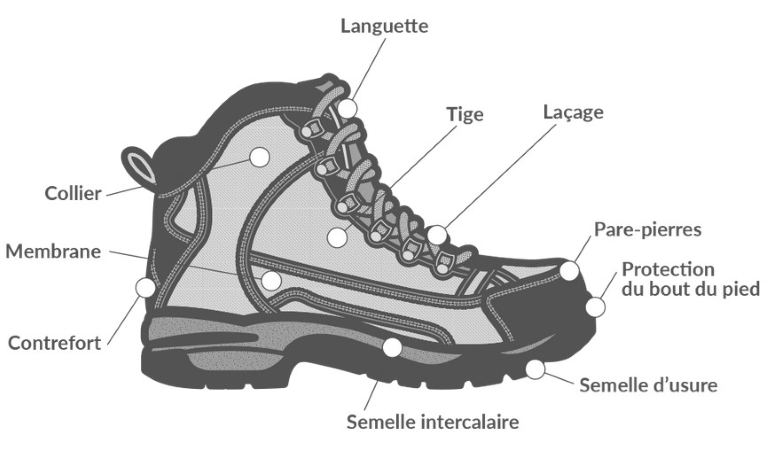Mathieu's tips
Before setting off on a hike with us, it's a good idea to choose and prepare your footwear correctly, in order to protect your feet, the major asset of the Pyrenean hiker on a (more or less) long trip.
For those of you who may have a few questions on the subject, here are a few simple but essential tips to help you find the shoe that's right for you!
We're going to assume that you're preparing for a mountain hike, since that's essentially what we're offering.
Technical features adapted to your practice
It's already important to evaluate :
1/ the place where you'll be practicing,
2/ the level of your stay and
3/ the duration of your stay, so you can adapt your choice accordingly.
These first three criteria will enable you to define the ideal "anatomy" of your future shoes, by quickly sorting the following characteristics of a shoe: rigidity / upper height / sole type.
In any case, never forget that the hiker's "fatal weapon" is the high upper, which protects the ankle from twisting, and from many "shocks" with trail-side stones. And the rigidity of the shoe is the best protection for your foot.
Nowadays, many hikers prioritize comfort, sometimes to the detriment of protection. I like to remind you that you need to make a balanced choice between comfort and protection: the comfort of your shoe won't save you from a sprain!

The table below cross-references the various criteria mentioned to give you an initial orientation in your choices:

Choice of upper
Low-cut shoes are all the rage!
Lightweight and comfortable, they meet the hiker's need for comfort. They are particularly well-suited to summer hiking, in low and mid-mountain areas, on fairly easy trails, where there are no scree, screes or ..... They leave the ankle exposed and therefore vulnerable.
Medium-upper shoes are versatile: they're fairly lightweight, and their ankle support is more supple than that of high-upper shoes. They offer comfort, lightness and protection for medium-mountain hikes, and can also be used for easy high-altitude treks.
High-shaft shoes are indispensable in the high mountains, where safety is paramount. They protect the ankles from many twists and turns, as well as from bumps and cuts on rocks, scree and scree.
Choose stiffness
Although this criterion is usually indicated on the shoe's presentation, you can easily test it by folding the hiking boot.
Soft shoes are designed for occasional hikes on easy trails.
Semi-rigid shoes are versatile, combining comfort and grip.
Rigid soles are used for high-mountain shoes.
Grip / Adhesion
My advice: don't compromise on these criteria: go for the best! Whatever your choice of upper, stiffness, color, lacing, aesthetics.... Choose the best grip and adhesion.
Deep, sculpted studs ensure good grip on all types of terrain. Grip, on the other hand, is particularly effective with VIBRAM, CONTAGRIP or MICHELIN soles.
These are two very important characteristics of hiking boots.
Choosing the right size
You've probably all experienced it: on a descent, your foot slips towards the front of the shoe. That's why you should ALWAYS allow for a safety margin when choosing your shoes. 2 cm is a good margin.
What's more, good lacing guarantees good foot support, so don't neglect it.
MY LITTLE TIP ?
It is only valid if you have shoes with a medium or high upper !
Here are a few additional tips:
NEVER GO HIKING WITHOUT FIRST BREAKING IN YOUR SHOES.
This is THE essential tip: you need to "break in" your shoes before setting off: by wearing them at home, at work, at night....
Waterproof or not ?
It's always a good idea to limit moisture in footwear, to avoid rubbing and therefore blisters... so yes, it's great to have waterproof shoes. That said, unless you have leather shoes and take very good care of them, other models, whose waterproofing is ensured by a membrane, end up taking on water.... My advice is to "help" them as much as possible to keep your feet dry, and for that, there's nothing better than gaiters!
Socks
You've bought a superb pair of hiking boots, waterproof, solid, with a high shaft and perfect grip..... don't ruin it with your great-grandfather's socks that he wore when he first went skiing in 1934!
I'm caricaturing, of course, and hope I won't offend any great-grandfathers...
Today's hiking socks have very specific characteristics, designed to wick away perspiration and prevent rubbing in very specific areas. They're put to the test, so choose quality ones. A sock that compresses slightly also facilitates venous return, reducing fatigue...
So there you have it, a few tips for a podologically successful hike!
That said, I accept no responsibility if you follow my advice and still get blisters! So the essential accessory to buy with your shoes is a box of anti-blister plasters!
Mathieu HOURET








